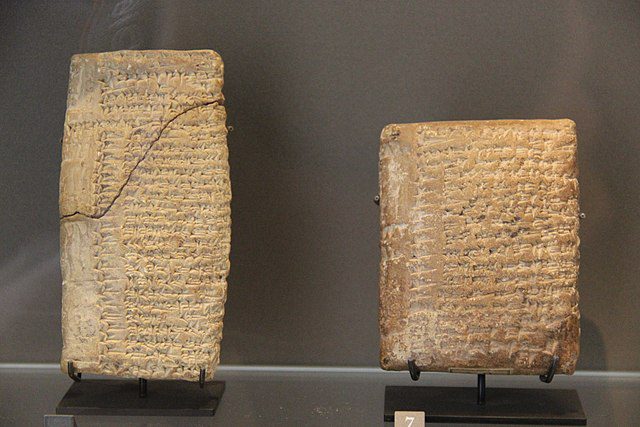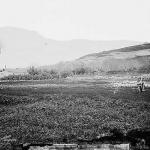
Adam Lee is an atheist writer and activist, who runs the blog, Daylight Atheism. He has written articles for AlterNet, Salon, the International Humanist and Ethical Union, Canadian Freethinker, Freethought Today, Free Inquiry, and Secular Future, the newsletter of the U.K.-based National Federation of Atheist, Humanist and Secular Student Societies.
*****
In this article I will be responding to a portion of his post, “Let the Stones Speak: Part 1” (unknown date). In my previous article, I tackled another portion of it: Genesis, Joseph, Archaeology, & Biblical Accuracy (+ A Brief Survey of Evidence for “The King’s Highway” in Jordan in the Bronze Age: Prior to 1000 BC) [6-8-21]. He wrote:
Anachronisms in the Patriarchal Narratives
[. . .]
The Arameans
The Arameans, a people who lived north of Israel in modern-day Syria, figure into the patriarchal narratives most prominently in the time of Jacob. Isaac’s brother-in-law, Laban, whose daughters Leah and Rachel Jacob married, is identified as an Aramean (Genesis 25:20, 31:20). According to the Bible, not only do the Arameans exist by the time of the patriarchs, but they are apparently a settled people: in Genesis 24:10-29 Laban and his family are depicted as the inhabitants of the city of Nahor, and at a later time as inhabitants of the city of Haran (Genesis 27:43, 29:4).
Outside the Bible, however, the first mention of the Arameans comes in Assyrian inscriptions dating to around 1100 BCE, and these texts clearly describe them as a nomadic people (Van Seters 1975, p. 29). It was not until several hundred years later that settled Aramean kingdoms began to appear on Israel’s northern border, most notably the kingdom of Aram-Damascus. . . . Later on these kingdoms were assimilated into the Assyrian empire and ceased to exist as distinct entities, and therefore the Bible’s picture of the Arameans “could reflect historical reality any time between the tenth and fifth centuries, but not any earlier” (Van Seters 1975, p. 33, original emphasis).
It’s not clear-cut at all, and there is certainly much and vigorous disagreement among archaeologists about when the Arameans appeared, and from whom they derived before the first undisputed historical mention of them in c. 11oo BC in the inscriptions of Tiglath Pileser I. But as an introduction to what follows, I would submit the following:
1) The Arameans [or, Aramaeans] didn’t spring out of thin air in 1100 BC, as if they had no historical pedigree at all, any more than I appeared in 1958, with no ancestors (in fact, I can show generation-by-documented-generation, ties to English royalty, and in one line, direct descent from Cleopatra).
2) Given the lack of consensus, particular theories of earlier Bronze origins or presence may be considered on their own merit and it makes no sense to cavalierly dismiss them.
3) From the fact of a first undisputed mention of the Arameans, it doesn’t follow that they didn’t exist before. All it proves is that this was when they were first mentioned. Presumably, they already had to be noteworthy enough as a people to account for reference to them as a people. Thus they obviously had to have a past history.
4) #1 and #3 being the case, then it is altogether acceptable and constructive to speculate what their “pre-history” was. That’s the “stuff” of archaeology and historiography.
5) Confirmation (ironclad conclusions) or possible support (speculative / tentative scholarly opinions) of the historical and geographical accuracy of biblical texts does not prove biblical inspiration, but it does show (or in less clear instances, possibly suggest) that these particular texts so analyzed and supported with outside data are accurate: which accuracy one (like myself) who believes in biblical inspiration would indeed fully expect.
I submit the following in the spirit of the archaeological inquiry and the first four points above: not as a settled conclusion. But the speculations of science today often become the “settled conclusions” of tomorrow. I submit the theory of relativity, quantum mechanics, the Big Bang, black holes, and plate tectonics, as examples in physics, astronomy, and geology.
I accept the dates for Isaac (c. 1713-1533 BC) on the basis of the conclusions of the Jewish Virtual Library. Jacob was his son. According to Genesis 25:26, Isaac was 60 when Jacob was born, which would mean Jacob was born c. 1653 BC and died in c. 1506 BC, since the Bible states that he lived 147 years.
First of all, let’s see if the two towns mentioned above in conjunction with the Arameans, existed at the time of Jacob. According to Encyclopedia.com:
Nahor is also mentioned in Akkadian sources dating from the beginning of the second millennium [2000 BC] to the middle of the seventh century b.c.e., as the name of a city in the Balikh valley. Nahor is first mentioned in Assyrian documents from Kanish of the 20th–19th centuries b.c.e. as an important station in the Assyrian trade with Asia Minor. Much information on the city during this period is contained in the Mari archives, from which it is clear that Nahor was a regional capital subject to Mari and a location of its agents. From Nahor supervision was exercised over the Balikh area and the upper stretch of the Habor river; in Nahor intelligence was collected from all parts of Aram-Naharaim.
As for Haran [or, Harran], Wikipedia summarizes:
During the Early Bronze Age (3000-2500 BCE) Harran grew into a walled city. The city-state of Harran was part of a network of city-states, called the Kish civilization, centered in the Syrian Levant and upper Mesopotamia. The rise of Harran closely mirrored the similar rise of its trade partners, Ebla, Ugarit, and Alalakh, in a process called secondary urbanization. . . .
The earliest records of Harran come from Ebla tablets (late 3rd millennium BCE). . . . It appears that Harran remained a part of the regional Eblaite kingdom for some time thereafter.
Royal letters from the city of Mari on the middle of the Euphrates, have confirmed that the area around the Balikh river remained occupied in c. the 19th century BCE. A confederation of semi-nomadic tribes was especially active around the region near Harran at that time.
A temple of the moon god Sin was established sometime at the end of the Neo-Sumerian Empire (circa 2000 BCE). . . .
By the 20th century BCE, Harran was established as a merchant outpost of the Old Assyrian Empire due to its ideal location. The community, well established before then, was situated along a trade route between the Mediterranean and the plains of the middle Tigris. It lay directly on the road from Antioch eastward to Nisibis and Nineveh. The Tigris could be followed down to the delta to Babylon. . . .
In its prime Harran was a major Assyrian city which controlled the point where the road from Damascus joins the highway between Nineveh and Carchemish. This location gave Harran strategic value from an early date. Because Harran had an abundance of goods that passed through its region, it became a target for raids. In the 18th century, Assyrian king Shamshi-Adad I (1813–1781 BCE) launched an expedition to secure the Harranian trade route.
All of these dates predate Jacob by quite a bit, so no “anachronism” there . . .
Now let’s look at the “prehistory” of the Arameans. First, it’s noteworthy that the Old Testament (RSV) mentions “Amorites” 79 times. It mentions Arameans only seven times (six in the Torah). This is consistent with the historical picture, generally accepted, of the Amorites being more powerful earlier in history and the Arameans later. The prophet Isaiah lived in the 8th-7th centuries BC. The last reference to Amorites in the Old Testament occurred in his book (17:9): “In that day their strong cities will be like the deserted places of the Hivites and the Amorites . . .”
I shall cite the article, “Is There a Connection Between the Amorites and Arameans?” by Daniel Bodi (Professor of History of Religions of Antiquity at Sorbonne, University of Paris), published in ARAM [ARAM Society for Syro-Mesopotamian Studies] in 2015 (pp. 1-35):
Abstract: A steady flow of new documents and scholarly publications dealing with the history of ancient Syria, the Amorites and the Arameans makes it possible to attempt a new synthesis of the data, revise previous views and propose some new ones. This article suggests several new arguments for the possibility of seeing some continuity between the 18th century BCE Amorites and the 12th century BCE Arameans. First, the geographical habitat of the various Amorite Bensimalite and Benjaminite tribes and the Aramean tribal conglomerates is compared. Second, the pattern of migration of the Amorite and Aramean tribes is analyzed. Third, some common linguistic elements are enumerated, like the term Ahlamu found among the Amorites and the Arameans. Fourth, the attempt of some scholars to place the Hebrew ancestors among the Aramean tribes in Northern Syria is discussed. And fifth, some matrimonial institutions, customs, social and linguistic phenomena common to the Amorites and the Hebrews are pointed out attesting to a cultural continuity of certain practices spanning several centuries. (p. 1)*Geographically, the Amorites and the Aramean clans originally occupied the same region. (p. 12)
6. The Aḫlamū and the Sutū Aramean Tribes*Just as with the term Amorite, the term Aram can stand for a toponym [place name], a geographic region in Syria, a conglomerate of tribes, and a language. The earliest attestation of the term Aramu appears as a toponym. The Ebla texts dating from the end of the 3rd millennium BCE mention a toponym a-ra–muki. The same toponym occurs in a list of geographical names from Tell Abū Ṣalābīḫ. In a date formula from the reign of Narām-Sîn (2254-2218 BCE), found on two tablets from Tell Ḫafaĝe, one reads, “In the day Narām -Sîn captuted Baba, the ruler of Simurrum, and Dubul, the ruler of a-ra–[meki] (l. 22) and [a-r]a-meki (l. 25) (Kh. 1934, ll. 22 and 25). (p. 15)
In a 14th century BCE Amarna letter addressed to the Pharaoh (EA 200), the latter is being informed that the Babylonian caravans from Karanduniyaš were attacked by the Aḫlamū Aramean clans. A robbery of Babylonian caravans by groups of pastoral nomads called Aḫlamū is probably described in this fragmentary letter while in EA 16:37-42, the Assyrian king Aššur–uballit writes to the Pharaoh telling him that the Suteans, another Aramean nomadic tribe, have pursued and kidnapped his messengers.*In the 13th century BCE, a letter from Emar (Tell Meskéné) quotes the report of two Aḫlamū Arameans who came from Sūḫu (region where Arameans settled in Babylonia).The Aḫlamū Aramean clans were mentioned since the Assyrian king Adad-nirari I (1307-1275 BCE) who states that his father Arik-den-ilu (1318-1307), was victorious in his military campaigns against various Aramaic nomadic tribes such as Aḫlamu, Sutûand Yauru. According to J.-R. Kupper, the collocation Aḫlamū Arameans indicates a close relationship between the two groups. (p. 17)In Middle Assyrian texts and documents (1400 to 1000 BCE), the references to nomads employ one of the three terms Suteans, Aḫlamū and Arameans. They are occupying the steppe between Tadmor (Palmyra) and the borders of Babylonia. In Assyria the Aḫlamū are first mentioned by Adad-nirari I (1305-1274 BCE) as opponents of his father Arik-den-ili (1317-1306 BCE) along with Suteans and Yauru. Šalmaneser I (1273-1244 BCE) encountered the Aḫlamū in alliance with the Hittites and the Hurrians in a desert area south of the major cities of Ḫanigalbat, perhaps near lower Baliḫ river. Like the term Sutean, the name Aḫlamū survived into the 1st millennium BCE as anarchaic designation for nomad populations in both historical and omen texts. In the inscriptions of Tiglath-pileser 1 (1114-1076 BCE), however, the term Aḫlamū is always qualified by Aramean. (pp. 17-18)*There seems to exist a linguistic continuity between the Amorite and the Aramaic languages. (p. 22)
Conclusion*As a result of intensive scholarly research on ancient Amorite traditions, history and customs, it has become increasingly evident that there exists a connection and a geographical, historical and linguistic continuity between the OB Amorite nomadic tribes and the MB Aramean ones. The geographic area where the ancient Amorites settled corresponds to the area occupied by the Aramean tribes at the end of the second millennium BCE. Among the conglomerate of various Northern and Southern Amorite tribes, the Bensim’alites and Benjaminites, one should probably seek for the precursors of later Aramean ones who appear in the 14th and 13th centuries BCE in the Syro-Palestinian geographic area. They have received different names in Egyptian and Akkadian texts. The terms Aḫlamū and Sutū are applied interchangeably to them. The Aḫlamū–Aramayū and the Suteans mentioned both among Amorite and Aramaic tribes seem to be a connecting link between the two and this connection should be further investigated.*The biblical texts place the origin of the patriarchs in the geographic area where some Aramean tribes evolved out of a former conglomerate of Amorite ones. For the end of the 2nd and the beginning of the 1st millennium BCE the Aramaic written documents are either non-existent or sparse. However, the Hebrew data although chronologically late can be used to fill that gap, since they show affinity and occasionally some continuity with the Amorite ones. (pp. 34-35)*[T]he Amorites, the Arameans and the ancient Hebrews stem from a common Northwest Semitic cultural, religious and linguistic substratum. (p. 35)
See also: “Was there G-M201 amongst the Arameans? (Part 1)”.
At the very least, we can say that serious archaeologists believe that a group called the Arameans (as direct descendants of the Amorites) could have existed as a distinct entity, in the time of Jacob, which is consistent with the biblical text.
***
Photo credit: Gary Todd (7-13-16). Cuneiform Clay Tablets from Amorite Kingdom of Mari, 1st Half of 2nd Millennium BC Ancient Near East Gallery, Louvre Museum, Paris, France [public domain / Wikimedia Commons]
***
Summary: Anti-theist Adam Lee claims that the biblical portrayal of “Arameans” could only refer to the 10th century BC or later. I present lots of archaeological & historical evidence to the contrary.
***













